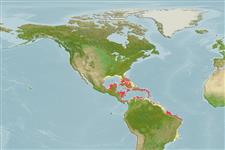Common names from other countries
>
Eupercaria/misc (Various families in series Eupercaria) >
Sciaenidae (Drums or croakers)
Etymology: Equetus: Latin, eques, -itis = horse, man in a horse, chevalier .
More on authors: Bloch & Schneider.
Environment: milieu / climate zone / depth range / distribution range
Sinh thái học
Biển Cùng sống ở rạn san hô; Mức độ sâu 3 - 30 m (Ref. 9710). Tropical; 36°N - 24°S, 98°W - 28°W
Western Atlantic: Bermuda, Florida (USA), and Bahamas to the Antilles (Ref. 26340) and Yucatan (Mexico) (Ref. 26938) to Brazil.
Bộ gần gũi / Khối lượng (Trọng lượng) / Age
Maturity: Lm ? range ? - ? cm
Max length : 27.0 cm TL con đực/không giới tính; (Ref. 26340); common length : 18.0 cm TL con đực/không giới tính; (Ref. 5217)
Các tia vây lưng cứng (tổng cộng) : 11 - 13; Các vây lưng mềm (tổng cộng) : 45 - 47; Tia cứng vây hậu môn: 2; Tia mềm vây hậu môn: 6 - 8. First dorsal fin very high with short base. Second dorsal and caudal fins dark with white spots and dashes (Ref. 26938). Head white with two dark brown bars, one through eye, the other more posterior and more diagonal, extending across chest to pelvic fins; body white with a broad dark brown band beginning on front of first dorsal fin, curving across nape, above pectoral fin, and running to mid-base of caudal fin; two narrower dark stripes above and below this band (Ref. 13442). Mouth small, inferior, nearly horizontal. Spinous dorsal fin very elevated, higher than head length. Gas bladder simple, carrot-shaped without appendages. Sagitta (large earstone) near rounded and thick (Ref 51721).
Occurs primarily on coral reefs. Secretive and usually solitary, under ledges or near small caves (Ref. 7251). Often seen during the day around the bases of corals (Ref. 26938). Feeds at night on crabs, shrimps, and polychaetes. Easily approached (Ref. 9710). Has been reared in captivity (Ref. 35420).
Life cycle and mating behavior
Maturities | Sự tái sinh sản | Spawnings | Egg(s) | Fecundities | Ấu trùng
Robins, C.R. and G.C. Ray, 1986. A field guide to Atlantic coast fishes of North America. Houghton Mifflin Company, Boston, U.S.A. 354 p. (Ref. 7251)
IUCN Red List Status (Ref. 130435)
CITES (Ref. 128078)
Not Evaluated
Threat to humans
Reports of ciguatera poisoning (Ref. 30303)
Human uses
Các nghề cá: buôn bán nhỏ; Bể nuôi cá: Tính thương mại
Các công cụ
Special reports
Download XML
Các nguồn internet
Estimates based on models
Preferred temperature (Ref.
115969): 26.3 - 28.2, mean 27.4 (based on 675 cells).
Phylogenetic diversity index (Ref.
82804): PD
50 = 0.7500 [Uniqueness, from 0.5 = low to 2.0 = high].
Bayesian length-weight: a=0.00851 (0.00413 - 0.01752), b=3.08 (2.91 - 3.25), in cm Total Length, based on LWR estimates for this (Sub)family-body shape (Ref.
93245).
Mức dinh dưỡng (Ref.
69278): 3.5 ±0.3 se; based on diet studies.
Thích nghi nhanh (Ref.
120179): Chiêù cao, thời gian nhân đôi của chủng quần tối thiểu là dưới 15 tháng (Preliminary K or Fecundity.).
Fishing Vulnerability (Ref.
59153): Low vulnerability (17 of 100).
